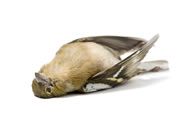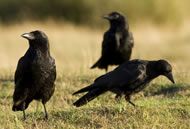





Birds
Bird Facts
There are around 10,000 species of birds on the planet today, each with their own unique habitat preferences, ranges, diets and behavioral habits. Below, Havahart® provides general facts about birds - including bird communication and migration - as well as important details about the birds that cause damage to homes and businesses.

General Bird Facts
- Taxonomic Class: Aves (subclass Neornithes)
- Number of Extant Species: Roughly 10,000
- Size range: 2"-9" tall
- Identifying Features: Feathers; a pair of wings; two legs; a beak; strong, lightweight skeleton.

Bird Habitats
Birds are some of the only creatures found on every continent of the world. With thousands of different species in existence, birds occupy a wide range of terrestrial environments. Many bird species often migrate from one habitat to another as seasons change. following climates ideal for breeding and gathering food.
A common thread among bird species is their usage of nests for shelter, protection from predators and raising young. Birds build their nests in secured areas like trees, tall grass and small nooks found in manmade structures.
Bird Diet
A bird's diet varies with its species. For example, hummingbirds survive mostly on flower nectar, while heron feed on fish. While different birds may be omnivores, carnivores or herbivores, they all require a balance of proteins, carbohydrates, fats, vitamins and minerals - much like humans.
Common bird foods include:
 blackbirds
blackbirds
 crows
crows
 ducks
ducks
 geese
geese
 heron
heron
 pigeons
pigeons
 sparrows
sparrows
 starlings
starlings
 heron
heron
 pigeons
pigeons
 sparrows
sparrows
 starlings
starlings
Bird Behavior
- Communication: Birds use a wide range of vocalizations and body language to communicate with one another. Each species has its own sounds and body movements for courting, alerting danger, showing aggression, defending themselves and more.
- Mating and Courtship: Male birds attract females through different visual and auditory displays like "dancing", showing off their colors, sharing food and singing mating songs. Once a male finds a mate, the pair will breed. 95 percent of birds remain with the same mate throughout their lives.
- Reproduction: Birds reproduce by internal fertilization and lay eggs with hard shells that hatch externally. Most females lay their eggs in a nest and incubate the eggs until they hatch. The incubation period can last anywhere from 9 to 80 days.
- Migration: Cyclical travel patterns occur in bird species that must relocate in response to important factors that fluctuate with the weather - like the availability of food. For example, many North American insectivorous birds will travel south for the winter as northern insect populations begin to decrease.
Common Nuisance Birds
Some birds can cause serious crop or property damage and are nuisances to home and land owners. While there are many different species that may cause damage, some of the most common nuisance birds in North America include:
 blackbirds
blackbirds
 crows
crows
 ducks
ducks
 geese
geese
 heron
heron
 pigeons
pigeons
 sparrows
sparrows
 starlings
starlings
Identifying Bird Damage
Bird damage often occurs as a result of their feeding, nesting and congregating habits.
Common bird damage includes:
- holes pecked in larger fruit crops
- corn damage: husks split open and soft meat of kernels pulled out
- sunflower damage
- killed poultry or livestock
- stolen pond fish
- overgrazed grass
- metal corrosion due to uric acid in feces
- clogged drainage systems, ventilation systems or machinery from nests or nesting materials
 crop damage
crop damage
 stolen fish
stolen fish
 overgrazed grass
overgrazed grass
 clogged gutter
clogged gutter
Bird Diseases
Birds carry several diseases and disease-causing parasites that may be directly or indirectly transmissible to humans. Typically these diseases are transmitted via contact with bird feces.
Common diseases that birds carry include:
- bird flu
- encephalitis
- E. coli
- Salmonella
- West Nile virus
Fun Facts
- Birds are the only animals in the world that have feathers.
- The most dangerous bird species in the world is said to be the Southern Cassowary. Cassowaries can grow up to 6 ft. tall and 130 lbs. and are equipped with large, sharp spurs with which they kick their enemies to defend themselves and their territory.
- Some birds like penguins and emus are classified as flightless: despite having wings, they cannot fly.
- The peregrine falcon can dive as fast as 200 mph when hunting prey.
- Although an ostrich cannot fly, it can run up to 60 mph.
- Many birds are considered incredible navigators: when transported 400 miles from its home, a champion racing pigeon can find its way back in 1 day.
- Owls can rotate their heads almost 360°, but they cannot move their eyes.
